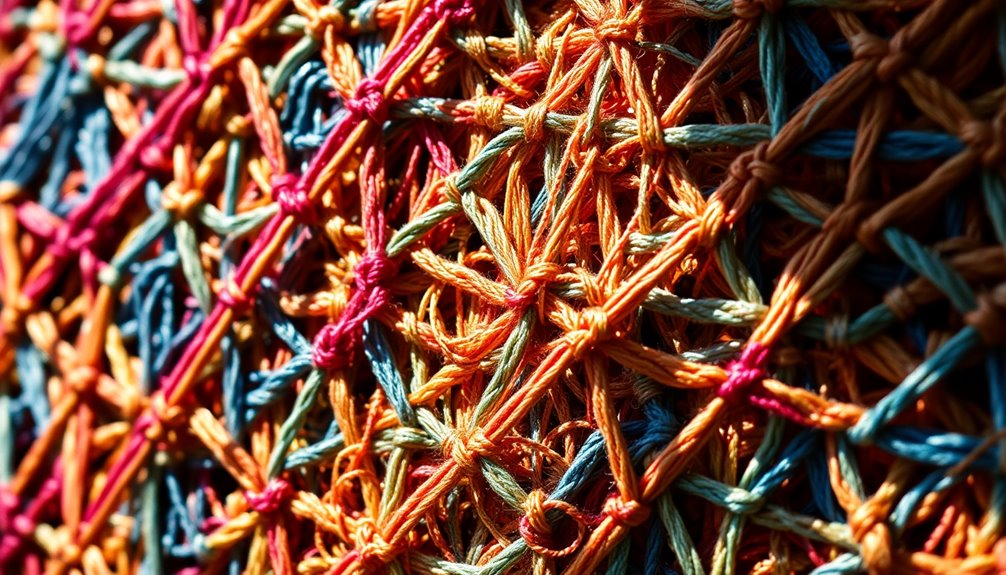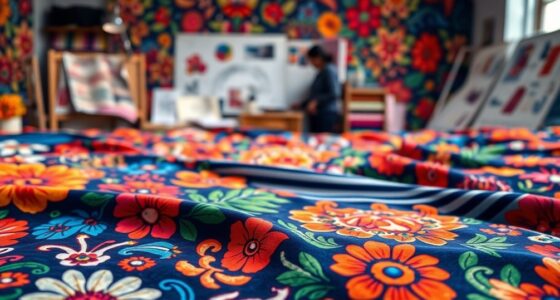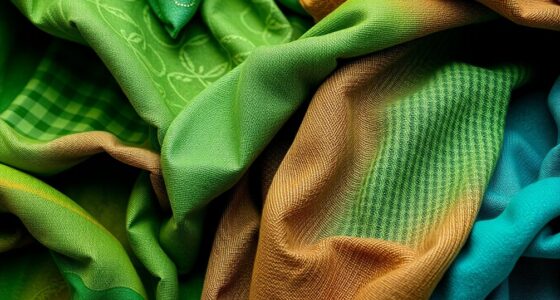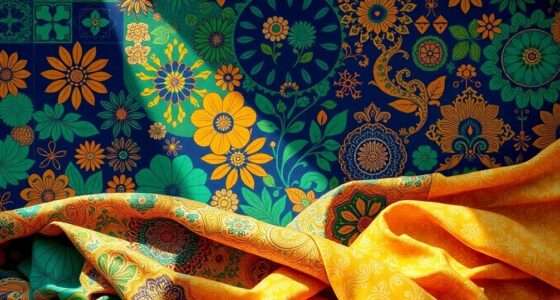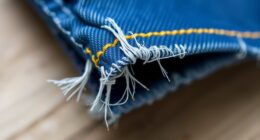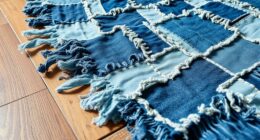To craft unique textile patterns, you've got to explore innovative design techniques. Digital printing lets you create vibrant, high-resolution designs on various fabrics. Resist dyeing methods, like batik and tie-dye, bring cultural depth and sustainability through natural dyes. Burn-out printing adds eye-catching translucent effects by selectively removing fibers. Don't forget fabric manipulation techniques, which give ordinary materials a twist. There's so much more to discover in the world of textile design!
Key Takeaways
- Digital printing techniques enable vibrant colors and intricate patterns, allowing for rapid prototyping and customization on various fabrics.
- Resist dyeing methods, like batik and tie-dye, create unique designs by blocking dye penetration, using sustainable natural dyes.
- Burn-out printing innovations selectively remove fibers to produce eye-catching translucent patterns while promoting eco-friendly practices with water-based inks.
- Fabric manipulation techniques, including pleating and draping, transform ordinary materials into extraordinary designs by adding texture and dimension.
- Emphasizing sustainability, innovative approaches advocate for natural fibers, water-based inks, and zero-waste design principles to minimize environmental impact.
Digital Printing Techniques
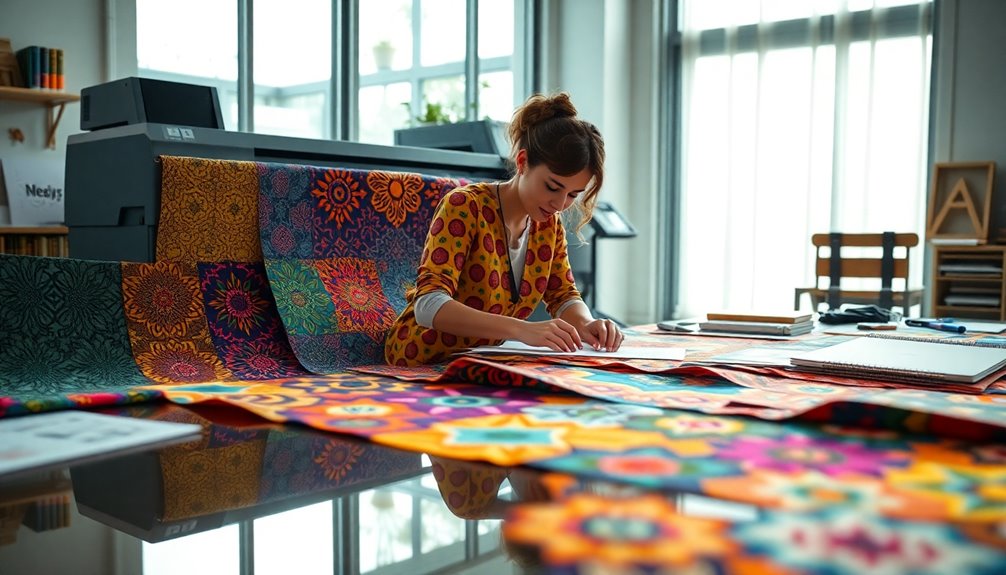
Digital printing techniques revolutionize how you apply designs to fabric, offering vibrant colors and intricate patterns that traditional methods struggle to achieve.
By using high-resolution digital printers, you can create unique patterns that cater to diverse tastes and preferences. This process also embraces sustainable textile practices, greatly reducing waste and minimizing environmental impact through lower dye and water usage.
With rapid prototyping, you'll quickly generate samples and adapt to shifting market trends without extensive setup time.
Versatile and efficient, digital printing works well on various fabrics, including delicate materials, making it ideal for fashion and home decor.
Plus, customization is a breeze, allowing you to craft one-of-a-kind fabric designs tailored to individual needs.
Resist Dyeing Methods
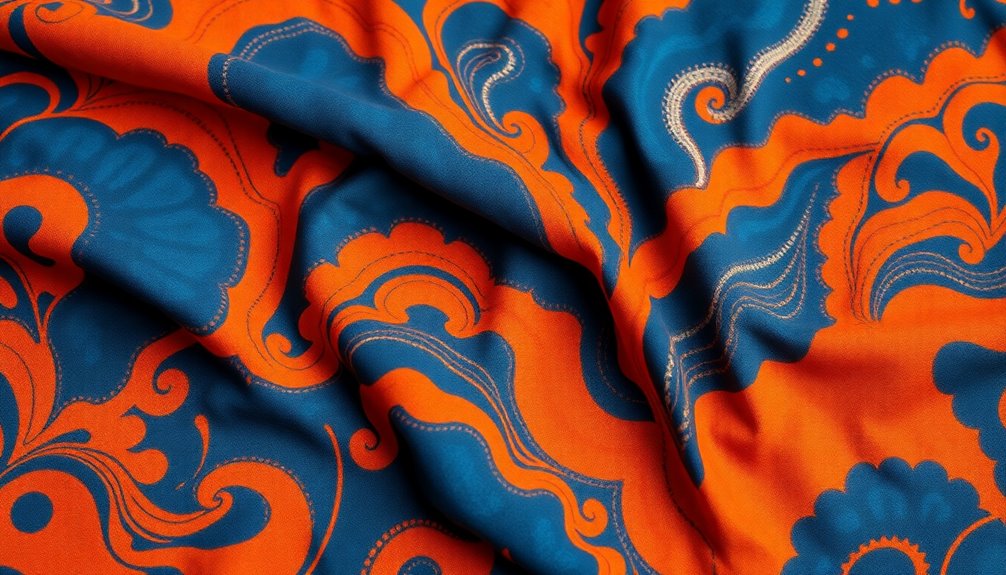
Exploring resist dyeing methods opens up a world of creative possibilities for fabric design. You can create intricate patterns by applying a resist agent, effectively blocking dye penetration in specific areas.
Techniques like batik, which uses wax, and tie-dye, where fabric is tied to resist dye, have roots in diverse cultures, with batik dating back over 2,000 years in Indonesia.
Embracing natural dyes enhances sustainability, as these colors often come from plants and minerals.
Additionally, advanced techniques like discharge printing allow you to remove color from pre-dyed fabric, resulting in vibrant designs that contrast beautifully with the original hue.
Immerse yourself in these methods, and you'll discover endless opportunities to express your creativity through textile art.
Burn-Out Printing Innovations

Burn-out printing innovations offer a mesmerizing way to transform fabrics into stunning works of art.
This textile technique creates unique patterns by selectively removing fibers, resulting in translucent designs that showcase the base fabric's color and texture.
With an eco-friendly approach, water-based inks reduce environmental impact while ensuring a soft feel and durability.
Here are some key benefits:
- Intricate, eye-catching translucent patterns.
- Enhanced design versatility across various fabrics.
- Utilization of fabric scraps for sustainable textile production.
- Innovative designs that align with the demand for sustainable fashion.
Fabric Manipulation Techniques
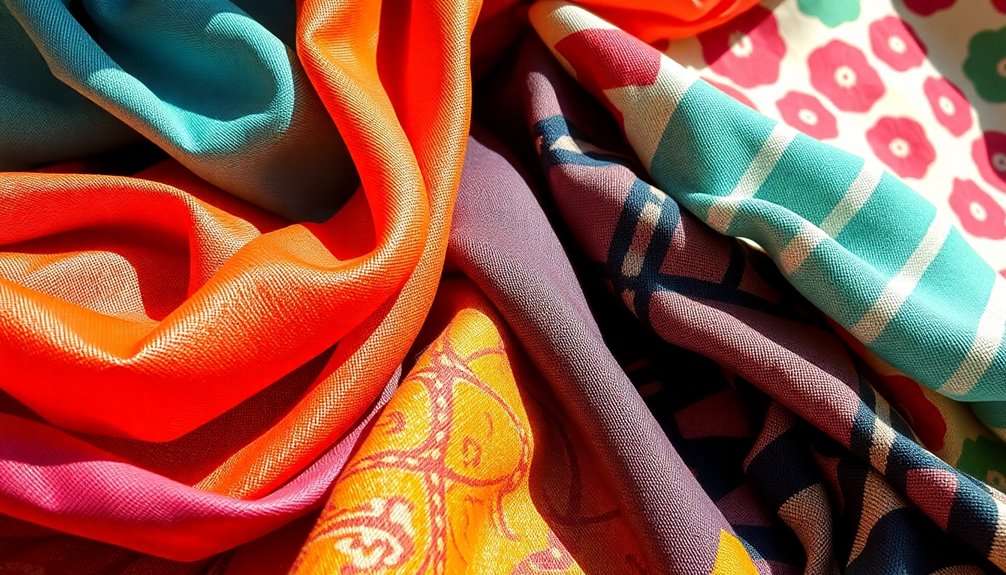
Fabric manipulation techniques breathe life into textiles, transforming ordinary materials into extraordinary designs. By altering the structure and texture of fabrics, you can create unique patterns and visual interest. Traditional methods like pleating and gathering add texture and dimension, while innovative techniques such as fabric burning introduce intricate patterns by selectively removing areas of synthetic materials. Draping allows you to explore movement and form in real-time, enhancing your design process.
| Technique | Description | Use Case |
|---|---|---|
| Pleating | Folding fabric to create texture and dimension | Skirts, blouses |
| Smocking | Embroidery gathers fabric for elasticity | Dresses, childrens' wear |
| Fabric Burning | Melting fabric to form unique designs | Accessories, statement pieces |
| Draping | Arranging fabric on a form to visualize designs | Couture garments |
| Folds and Darts | Shaping fabric for fit and visual interest | Tailored clothing |
Sustainable Approaches in Textile Design
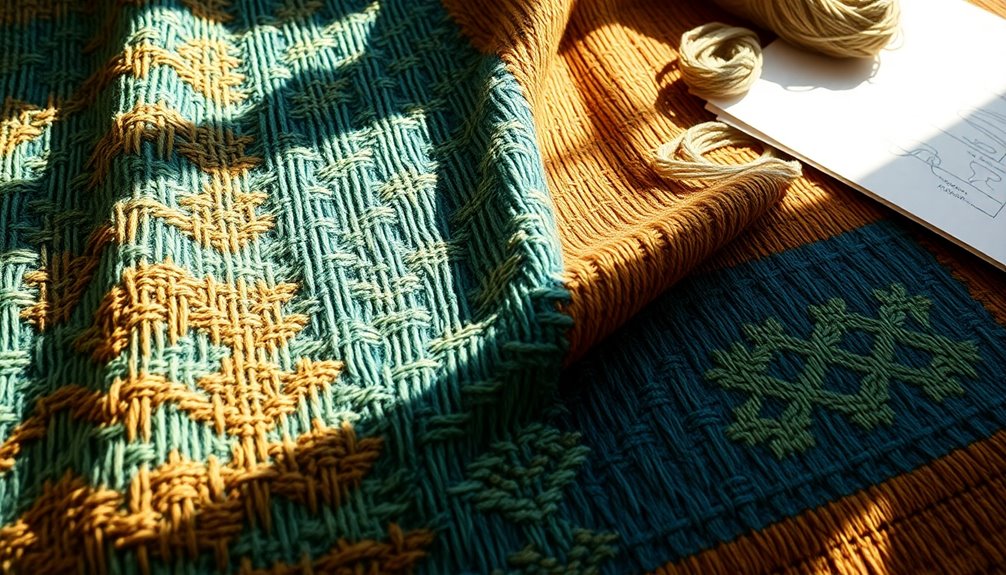
As the demand for eco-friendly practices grows, sustainable approaches in textile design are becoming essential for responsible creators.
By embracing these methods, you can showcase your commitment to the planet while creating beautiful pieces.
Here are four key strategies to take into account:
- Natural Fibers: Use high-quality, sustainable materials instead of harmful synthetics.
- Water-Based Inks: Opt for eco-friendly printing techniques that minimize chemical runoff.
- Zero-Waste Design: Implement principles that reduce fabric waste and encourage circular design.
- Social Responsibility: Collaborate with local artisans and NGOs to guarantee fair compensation and support marginalized communities.
Frequently Asked Questions
What Are the Different Types of Textile Design Techniques?
When you're exploring textile design techniques, you'll find a variety of methods to create unique fabrics.
Weaving interlaces yarns, producing various textures and strengths. Knitting forms flexible fabrics through interlocking loops.
Surface design techniques like dyeing and painting enhance the visual appeal, while methods like immersion dyeing offer eco-friendly options.
Additionally, specialized techniques like digital and burn-out printing allow for precise patterns, pushing the boundaries of creativity in textile design.
What Are the Techniques Used in Creating Textile Art?
To create textile art, you can explore various techniques.
You'll find weaving and knitting form the fabric's structure, while surface design methods like dyeing and painting enhance visual appeal.
Digital printing allows for vibrant, intricate designs, and specialized techniques such as burn-out and resist printing offer unique textures.
You might also enjoy block printing and tie-dye, which add cultural flair and personal expression to your textile creations.
Each method opens a world of possibilities!
What Were Some Innovations in the Textile Industry?
In the world of textiles, innovation's a vibrant dance, blending creativity with technology.
You've seen how digital printing's transformed the industry, letting you explore endless designs and colors while saving resources.
Sustainable practices, like water-based inks, have lessened the environmental impact.
Plus, you can enjoy dynamic textiles through lenticular printing, while rubber printing offers unique textures.
Reflective techniques even enhance safety, making your clothing both stylish and practical for any adventure.
What Is the Newest Method of Fabric Printing?
The newest method of fabric printing is sustainable digital printing, which uses advanced technology to create intricate designs while minimizing environmental impact.
You'll appreciate that it requires fewer dyes and less water compared to traditional techniques.
Another exciting option is water-based burn-out printing, which offers eco-friendly inks that enhance comfort.
Additionally, lenticular printing adds dynamic visuals, making your fabrics truly stand out.
These innovations not only look great but also promote sustainability in fashion.
Conclusion
In the world of textile design, you’re not just creating patterns; you’re launching a revolution! With digital printing, resist dyeing, and burn-out techniques, you can transform ordinary fabrics into masterpieces that could make Picasso weep! Imagine fabric manipulation that defies gravity and sustainable methods so innovative they could save the planet! Embrace these extraordinary techniques, and you’ll not only be crafting unique patterns, but you’ll also be redefining the future of fashion—one stitch at a time! As you explore the limitless potential of these methods, consider their application beyond apparel—think about how textile transformation in home decor can breathe new life into living spaces. From striking wall hangings to dynamic upholstery, the possibilities are endless when imagination meets innovation. So, unleash your creativity and watch as your designs not only elevate personal style but also inspire a movement towards a more sustainable and visually captivating world.
